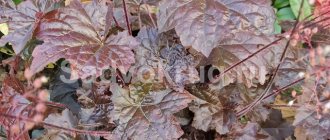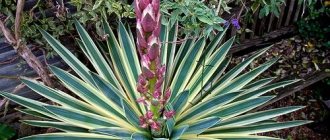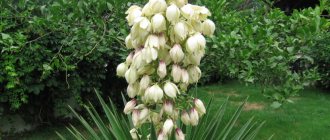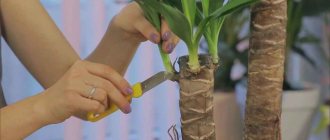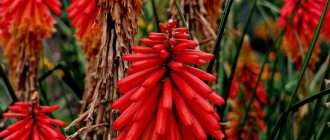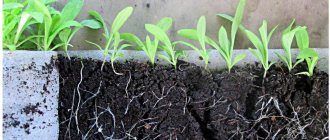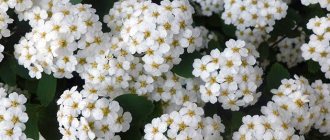For gardens in central Russia, yucca is a rather exotic plant. In natural conditions, it can be seen in the northeastern United States. Many varieties grow well on the Black Sea coast and in Central Asia. In general, there are more than 30 species of yucca, among which there are both false palms with a thickened tree-like stem, and simply bunches of large leaves that resemble sharpened swords, practically without a trunk and growing straight from the ground. Yucca blooms only briefly, throwing out an arrow up to 1.5–2.0 m long with a panicle-shaped inflorescence consisting of large (up to 7 cm) white bell flowers, emitting a pleasant aroma in the evenings.
This plant, unusual in shape and size, can grow alone - for example, in a rock garden. If you choose neighbors for yucca, then it will look best among ornamental grasses or other neighbors with the same nondescript foliage.
Garden yucca (filamentous) is best suited for growing in the climatic conditions of the middle zone. It is this species that, with proper care and preparation for wintering, can withstand fairly low temperatures (down to –30 °C). It differs from other yuccas by the presence of thin threads - hairs along the edge of the leaf.
Yucca description
When cultivated in open ground in central Russia, 3 types of yucca are practiced:
- filamentous - this shrub got its name from the thin fibers hanging along the edges of the hard leaves. This is one of the most frost-resistant species of yucca, able to withstand temperatures down to -30° C for a short time. Its almost stemless rosette consists of spirally arranged, erect, blue-green sword-shaped leaves about 70 cm long and up to 4 cm wide, pubescent with twisting threads. When flowering, it throws out a flower panicle up to 2 m high, densely covered with drooping, yellowish-white flowers, in place of which, after flowering, seed pods up to 5 cm in diameter are formed. A variety of yucca filamentous are variegated forms - shrubs with white or yellow-pinnate leaves. The most common variegated varieties of filamentous yucca are “Bright Edge” and “Color Guard”, “Gold Heart”, “Ivory Tower”;
- glorious - a type of yucca that grows into a spherical bush or tree up to 2 m tall. The dark green leaves of this shrub have a bluish coating, jagged edges, with a prickly thorn at the top of the leaf. The length of the leaf plate reaches 60 cm. Its peduncle is up to 2.5 m in height, covered with large creamy-purple bell-shaped flowers.
- glaucous is a type of yucca characterized by a short trunk, long narrow gray-green leaves and a tall peduncle with a racemose inflorescence of greenish-white flowers. Another name for this species is “Holy Candle.”
In the southern regions, Yucca ivory, Yucca avolifolia, Yucca Schidigera, Yucca rostrata, Yucca scotti, Yucca aloelia, Yucca gloriosa and other species also grow well.
Yucca usually blooms 3-5 years after planting in June or July. When grown in the southern regions, it can bloom twice a year - in summer and autumn. In landscape design, yuccas are used in single and group plantings, planted in rockeries, flower beds, and along fences.
How to care for yucca so that it blooms every year?
After the plant has been planted, it needs moderate watering and sanitary care, which consists of removing dried foliage and faded flower stalks, trimming unnecessary shoots and small and infrequent fertilizing.
You need to water the yuca right to the root, avoiding water getting into the core of the rosette, as this can lead to rotting of the crown.
The plant, as a rule, is rarely affected by pests and diseases. With good shelter, it can survive the winter with minimal harm, even in the conditions of the Moscow region.
The soil under the garden yuca needs to be loosened from time to time so that the roots of the plant can breathe and the lower leaves do not rot, and of course, weeds and fallen leaf blades must be removed.
If you initially chose the wrong place to plant yuca, then it can be replanted before it is three years old.
If you properly care for yuca, it will live at home for many years, will bloom beautifully and delight you with the uniqueness of its inflorescences.
Yucca filamentous planting in the ground
When planting yucca, be sure to wear gloves, as the edges of the leaves can injure the skin of your hands. It is carried out in several stages:
- It is recommended to dig the planting hole in the fall;
- if a purchased seedling is used for planting, then before planting the plant should be hardened off, taking it outside for 10-14 days and gradually increasing its stay in outdoor conditions;
- Immediately before planting the yucca, a layer of gravel should be poured onto the bottom of the hole for drainage. It must be sprinkled with ash and soil on top;
- place the seedling in the center of the hole and cover it with soil mixed with sand, pressing it lightly;
- water the yucca, pouring water under the seedling so that it does not fall on the plant’s rosette.
Preparing garden yucca for winter
It's a completely different story if the plant lives in the garden. Here the first priority is to prepare proper, reliable shelter from frost. It is important that the humidity under the protective layer does not increase, otherwise the leaves of the plant will begin to rot.
How to prepare young plants
Before you insulate your yucca for the winter, you should familiarize yourself with the features of the process depending on the age of your flower. So, young seedlings that are about to winter for the first time are covered in the fall with plastic bottles, having previously cut off their bottom. The container is securely dug into the ground around the plant, well sprinkled with soil so that sharp winter winds do not tear it off. As a rule, such protection is quite enough for young yuccas.
What to do with an adult yucca
It is a completely different way to prepare an adult plant for wintering. In the fall, as soon as the first night frosts arrive in the Moscow region, the leaves are tied into one large vertical bunch - this will protect the central rosette of growth from the cold. Around such a “tied” tree, a small hut is built from pegs of suitable length, wrapped with insulation, such as spunbond. The free edges of the protective material should be securely fixed to the ground surface. Such an insulating structure can only be dismantled when the threat of spring frosts has completely passed.
What does yucca like:
This unpretentious tropical plant will not cause much trouble when growing. It loves the sun and grows even in soils depleted of nutrients.
place
Yucca feels best when planted in open, well-lit, elevated areas. It can also tolerate short periods of light partial shade. Being planted in shaded places or lowlands, yucca loses its external attractiveness, becomes very elongated, its rosettes become thin and loose from lack of light, and the leaves of variegated forms turn pale.
priming
In the wild, yucca is a semi-desert plant, so it is unpretentious to soil quality and grows well on sandy, rocky and calcareous soils. When planting it in a flowerbed, it is recommended to use a loose soil substrate consisting of leaf and turf soil, sand or small stones, and humus. If the site is dominated by heavy clay or acidic soils, sand and lime should be added to the soil before planting yucca.
Attention! Yucca does not tolerate stagnant moisture, so waterlogged, swampy or heavy soils are not suitable for it.
planting depth
The size of the hole intended for planting yucca depends on the size of the seedling. On average, it should be twice the size of the plant’s root system. For young plants, a hole measuring 50x50 cm is quite suitable, for large adult plants - approximately 100x100 cm. At the bottom of the hole, you should definitely arrange a drainage layer using gravel, broken brick or expanded clay. The top drainage layer must be sprinkled with ash and soil. The average planting depth of yucca is 10-15 cm for young seedlings, and 40-50 cm for large ones.
watering
Tolerating heat and drought well, yucca needs moderate watering. An indicator that this plant is experiencing a moisture deficiency is sagging fibers on the leaves of Yucca filamentosa and curling of leaves in other species. When watering exotic plants, water should be poured only at the root, trying to avoid water getting into the middle of the rosette. It is important to remember that excess moisture in the soil leads to rotting of the yucca roots.
feeding
To feed young plants, it is recommended to use complex mineral fertilizers - ideally, special fertilizers intended for succulents are suitable. They should be applied at the end of spring, and then again at the end of summer. Starting from 3 years of age, organic fertilizers can be used to feed yucca, applying them in April. It is recommended to carry out the next feeding in June - before the start of flowering, the last one - after flowering.
Yucca garden: subtleties of planting and care
Garden yucca is often called a tropical plant. This is not entirely true. Its habitat is the semi-desert regions of North and Central America with long hot and dry summers and cool winters. This affected the structure and cyclical development of the plant.
The types of yucca we cultivate as outdoors are an evergreen perennial with a short, loose stem and a cluster of tough, sword-shaped leaves. They are designed to accumulate and retain moisture (trunk) and prevent its evaporation (leaves). The rhizome is thick and branched, going to great depths. This is also an indicator of adaptation to drought conditions.
Despite the “evergreen”, garden flowers are characterized by cyclical development with a pronounced dormant period, which occurs in the cold season. It is these features that make it possible to grow yucca in temperate climate gardens. Subject to certain nuances of agricultural technology, of course.
Growing conditions
First, let's try to create conditions for the flower that are close to the natural environment.
- Location: in the sun. If you have a flowerbed in full sun where no other flowers want to grow, it may be suitable for yucca. Being a succulent, the plant can easily withstand temperatures up to +35°C and dry air, in which 5-6 times more moisture evaporates than it receives. And, conversely, in the shade the yucca will not reveal its potential, and there may be problems with flowering.
- The soil is light, crumbly, well drained. The best option is sandy loam. Clay soils require loosening with river sand and peat chips. The plant does not tolerate stagnant moisture, so if groundwater is close, it is best to artificially raise the flower bed.
- A place protected from the wind. Yucca does not like drafts, especially in winter. Although its flower stalks are strong, they can break under the weight of the flowers in windy weather.
Planting in open ground
Let's consider the features of growing garden yucca, starting with planting a young seedling and ending with caring for an adult perennial. (We omit the technology of growing from seeds, since garden centers most often sell seedlings, rooted cuttings or cuttings with a piece of rhizome).
It is best to plant yucca in the garden in the spring, so that the plant goes into winter fully strengthened and hardened. This is done no earlier than May, when the night temperature exceeds 10°C.
Select a sunny place for planting in advance, prepare a planting hole 50–60 cm deep. If necessary, drainage of small stones, crushed stones, and pieces of brick is laid at the bottom. Sprinkle it with a layer of fertile soil generously seasoned with wood ash.
If the soil in the garden is light and fertile, use it. If it is heavy and poor, prepare a substrate from turf soil, well-rotted compost, and sand.
A seedling is placed on the prepared “cushion” and covered with prepared soil. The root collar is brought level with the soil surface.
After planting, water the hole and mulch the top with dry soil. The seedling is pressed well around the stem.
Care after landing
How to care for a seedling after planting? Very simple.
- As necessary, loosen and clear the root zone of weeds.
- During dry periods, water occasionally.
- Regularly inspect for pests (possible aphid infestation).
An adult plant is hardy, tenacious and unpretentious. In the middle zone, the moisture that falls with rain and morning dew is sufficient for it. Even if “overboard” is more than +30° C, do not rush to grab the watering can. Let the yucca pretend that it is in its native Mexico.
In drier steppe regions - in the Donbass, Rostov region, Krasnodar region - watering is needed, but not too frequent and abundant.
In the spring, the perennial freed from shelter is fed with a complex of complete fertilizers (30–40 g/m²) or an organic solution (chicken manure - 1:20, mullein - 1:10). If the bush has been mulched with humus since the fall, no additional feeding is needed.
Please note that with proper care, yucca can grow in one place without replanting for up to 20 years. Depending on the type and method of formation, it forms lush rosettes or “trees” reminiscent of a palm tree.
Formation of an adult perennial
Yucca, cultivated in open ground, most often grows in bushes consisting of several rosettes of large sword-shaped leaves. Over time, the mother plant becomes overgrown with root suckers. The bush thickens, which does not have the best effect on its condition.
- The feeding area decreases, the plant becomes smaller and weaker.
- The air permeability of the soil in the area of the roots deteriorates, and they can rot.
- Its decorative value is reduced.
- Weak specimens do not have enough strength to flower.
Every year the bushes must be thinned out, leaving the largest, strongest rosettes, usually 3–5 per 1 m². Often, after flowering, the mother plant dries out. It's okay, this is typical for agave plants. Leave a young bush instead.
Some people thin out the yucca in the fall, while others leave this work until the spring. In our opinion, the second option is preferable. Firstly, it is easier for a thickened bush to overwinter. Secondly, during spring thinning, excess rosettes can be used for propagation, but in the fall they will most likely have to be thrown away.
Garden yucca does not bloom immediately after planting, but in the second, third, sometimes fourth year. Its peduncle is strong, woody, rises 1.5–2 m, forms a branched panicle consisting of hundreds of white, greenish, cream bells. After flowering, it must be cut with pruning shears or cut down with a hacksaw. It won't work any other way. There is no point in collecting seeds; it is easier to propagate the flower by root suckers.
In addition, in spring and autumn it is necessary to clean the base of the bush from old, damaged, dried leaves. Over time, you can get an interesting palm-shaped stem, which will only add decorativeness to the yucca.
Yucca diseases, how to treat
Usually yucca does not get sick, but hot, dry summers can cause it to be attacked by pests:
- spider mite;
- whiteflies;
- scale insects;
- thrips;
- mealybug;
- aphids.
You can get rid of them by treating plants with insecticides. Among home remedies, treating bushes with a solution of ash and laundry soap will help cope with pests.
In rainy, damp summers, yucca may suffer from an invasion of slugs. High soil moisture also promotes the development of fungal diseases and bacterial rot. Most often, yucca is exposed to:
- necrosis;
- gray rot;
- cercosporiosis of leaves.
Such pathogenic infections can be dealt with only with the help of fungicides and subject to timely treatment.
Winter in indoor culture
What kind of home care is needed for yucca in winter? At this time of year, filamentous yucca requires a period of rest with infrequent watering .
The temperature should be reduced to 10-12ºС; It would be optimal to keep it on a well-insulated but not heated balcony. In this case, the daylight hours must be extended (with the help of additional lighting) to 16 hours.
A hardy, undemanding plant can survive the winter even if kept in a warm room with the usual moisture regime in combination with an artificially created long daylight period.
How to feed yucca for abundant flowering
The yucca flowering period occurs in mid-June and lasts about a month. To provide it with the opportunity to abundantly form large flower buds during this period, it is recommended to add superphosphate fertilizers to the soil in the area where this exotic grows in early June.
Yucca: cultivation and care in open ground - watering and fertilizing
With fertilizing and watering, the main thing is to avoid excess. With excessive watering, the roots begin to rot, and with insufficient watering, the leaves curl, and the threads droop and hang (in yucca filamentosa). With proper watering, the flower has straightened leaves with twisted threads.
The first two years of its life are fertilized with complex mineral fertilizer for succulents in May (before the start of active growing season) and after flowering. In the 3rd year, when the root system is well developed, it will be possible to feed with organic fertilizers.
It is better to feed adult flowers in mid-spring (April) with liquid organic fertilizer. In early June, a handful of superphosphate is poured around the trunk; after watering or rain, fertilizers reach the roots and stimulate the formation of flower shoots and buds.
Yucca in the fall, how to prepare yucca for wintering
Complex fertilizing applied at the beginning of autumn - 30-40 days before the onset of cold weather, will allow the plant to prepare for winter. Snow that suddenly falls at the end of autumn or at the beginning of spring is not scary for yucca. Long-term frosts and long-lying thick layers of snow are much more dangerous for her.
Attention! To prevent the plant from being damaged by the weight of fallen snow, it is recommended to tie it.
Preparation for wintering depending on the climate in the region
Warming an exotic crop on the eve of winter largely depends on the climatic conditions of the plant growing area. If the winters in your area are not severe, then you can not build a frame of pegs around the crop, but simply tie the leaves into a bunch and insulate the root circle with straw or even a small layer of earth.
If you are likely to experience severe frosts, it is better to prepare an air-dry shelter in advance. The principle of its organization is described above. This way you will be able to preserve exotic leaves.
In general, in the middle zone, yucca is able to successfully overwinter and retain its vitality for new flowering, if optimal wintering conditions are created for it.
How to cover a yucca for the winter
Yucca filamentous, like other varieties of this exotic grown in temperate climates, tolerate winters quite well, withstanding down to -15° C, and when covered, even up to -30° C. For this reason, yuccas growing in open ground do not They dig it up and just cover it up at the end of October - beginning of November. It is advisable to do this in dry weather. The method of covering a yucca for the winter depends on the availability of covering material and the size of the plant. Small yuccas should be tied with twine, collecting the leaves together, and then wrapped in burlap or agrofibre and covered with a box. Lay spruce branches or a layer of fallen leaves on top of it and secure everything on top with covering material - roofing material or foam plastic. Large yuccas can be insulated by covering the soil around them with a layer of leaves and placing boards on top. The plant itself must be collected in a bundle and tied with a rope, then covered with polyethylene on top, and the base of the trunk covered with soil.
Attention! The shelter must be opened at the end of March to prevent mold growth.
Rules for successful wintering
The key to successful wintering of a flower is adequate autumn care and preparation of the flower for the cold. Recommendations on how to prepare garden yucca for winter are simple and even a novice gardener can do it. They insulate and choose the type of shelter for the flower depending on the climatic conditions and the characteristics of the cold period in the region.
You need to prepare yucca for winter as follows:
- remove dried inflorescences and leaves, damaged parts of the plant;
- feed the plant with mineral fertilizers;
- Cover the flower with a thick cover, which will allow you to maintain the optimal temperature for the plant and prevent cold and dampness.
The main thing is to remember that garden yucca normally tolerates frost down to -20 °C. Therefore, if the winter in the region is much warmer, you should not be particularly zealous - the plant can wither and rot under cover. There is also no need to flood the yucca and add a large amount of fertilizing. The flower is drought-resistant and does not require large doses of fertilizer. You need to think about the future wintering even when planting and choose a sunny, but protected from winds and drafts place.
Shelter
It is important to know not only how to insulate yucca for the winter, but also with what. Even before the onset of the first hard frost in dry weather, it is recommended to tie the bulk of the leaves into a bunch around the trunk. The resulting bundle is wrapped tightly so that it does not unravel. The lower tier of leaves are left on the ground to serve as protection for the root system. Additionally, the leaves can be covered with dry foliage by pressing it with something. You can tie up all the leaves and cover the roots with an additional layer of soil and mulch. For a mild continental winter, this shelter will be enough. Young, immature plants can be covered with plastic containers, which should be pressed well into the ground.
In severe winter conditions, it is recommended to additionally cover both young and old plants with the frame method. In this case, wooden square or cone-like frames are built, which are wrapped with agrofibre or spunbond. In Siberia, yucca is covered with wooden boxes, which are insulated with a special material, and on top with an additional layer of snow. After removing the cover in the spring, you should not immediately cut off yellowed and frostbitten leaves - the plant needs an adaptation period. Only when the yucca begins to throw out young leaves can you begin sanitary pruning.
Suitable temperature and humidity
Yucca tolerates drought normally, but excessive frequent watering can be detrimental to it. Even in summer, the plant is watered infrequently, and in autumn the amount of watering is reduced to a minimum. In winter, the root zone is well moistened and mulched to retain moisture for the entire period of shelter. A gradual decrease in temperature is also normal for a flower. For the plant's dormant period, the temperature in the shelter should be several degrees higher than outside and not rise above 10 °C, otherwise the yucca will sap. Therefore, when the minimum above-zero temperature has established, the shelter must be removed.
Top dressing
Yucca does not need frequent fertilization. Usually the flower is fed twice a year before and after flowering. Nitrogen-containing fertilizers are not recommended for use at all. Mineral fertilizers for succulents, compost or humus diluted with water are optimal for feeding. Top dressing can also be foliar. To do this, the leaves of the flower are sprayed with fertilizer.
Despite its southern origin, yucca tolerates winter well.
The main thing is to provide the flower with adequate care and take care of its shelter. And then she will delight you not only with beautiful flowers, but also with a pleasant aroma.
Yucca after winter, care for yucca in spring
With the onset of spring, after the winter shelter has been removed from the yucca, it must be untied and inspected for damage and fungal diseases. Then prune the dry leaves to allow the bush to open up. In early spring, it also needs to be fed with mineral or organic fertilizers, providing the plant with the opportunity to actively develop.
Yucca at home care
Location
The natural habitat of yucca is characterized by a dry climate and rare but plentiful rains. In nature, yucca is accustomed to bright sun. Young plants are especially demanding of the sun. However, in the microclimate of an apartment, the plant feels uncomfortable in direct sunlight. The best location in the room is east or west windows.
Lighting
The optimal day length for yucca is 16 hours. When there is a shortage of sun, it is illuminated with fluorescent lamps. In summer, the plant benefits from fresh air and sunlight, subject to mandatory protection from dampness and rain. If the yucca spends the summer in a room, be sure to ensure daily ventilation of the room. In winter, the plant especially needs good lighting.
Temperature
In spring and summer, the best temperature for yucca is 20–25 °C. In hot weather it is not recommended to leave it in the open sun. The plant needs shading. To avoid overheating, place the container with yucca in the shade and spray it after cooling. The optimal temperature in winter is 8–12 °C.
How to prune yucca correctly
Yucca pruning is carried out with a sharp and clean knife, subject to the following conditions:
- the plant must be watered 1-2 days before pruning;
- the stem is cut 8-10 cm below the beginning of leaf growth so that the bark does not peel off or splits form;
- All cut areas must be treated with a fungicide or sprinkled with charcoal before drying. The stumps of old plants can be treated with garden varnish.
After pruning, after 3 weeks new shoots will appear on the old bush. If the plant is mature and healthy, then you can leave up to 5 such sprouts on it, and the rest should be removed. Small yuccas leave no more than 2 hatched buds. The cut top is also used as a seedling, only for this it must first be rooted by planting it in a greenhouse.
Yucca pruning for beauty and rejuvenation
Yucca pruning is carried out in order to rejuvenate the plant and obtain new growth. To awaken dormant lateral buds, in early spring, after the snow has melted, the main stem is cut off, stimulating the development of lateral buds, from which new rosettes will subsequently develop. If there is no need to grow new shoots, the plant has overwintered well; only bad and dry leaves are removed.
Yucca is very decorative when it grows in one stem. With proper care, the height of the peduncle exceeds 1.5 m, the number of beautiful large flowers can reach 250 pieces on one plant. Before subjecting the crop to shearing, think about whether it is necessary to resort to this procedure.
Typically, yucca is pruned after flowering, removing faded stems and bad foliage. To make the plant decorative, the leaves are not cut off completely, leaving a distance of 3-5 cm from the trunk, so the trimmed yucca will not look naked, the trunk will look like it has scales. Even in winter, yucca in the snow decorates the garden, becoming a bright element in the landscape design of your site.
Why does yucca dry out, how to save yucca
The appearance of the leaves is an indicator of proper yucca care. As soon as any problems appear, this is immediately visible in its leaves.
- Dried brown tips on yucca indicate a lack of moisture in the air and the presence of cold drafts. In the first case, spraying the plant will help correct the situation; in the second, replanting it in a more comfortable place.
- The formation of brown spots on the leaf blade is a sign of a fungal disease that develops as a result of waterlogging of the soil caused by excessive watering, insufficient drainage, and low aeration of the soil substrate.
- The appearance of light, dry spots on the leaves is caused by an excess of sunlight. You can avoid them by creating light partial shade for the plant.
Types of filamentous yucca (filamentosa)
Garden (filamentous) yucca
Garden (filamentous) yucca is a plant that is grown in garden plots, street gardens, and is also used in creating a variety of flower arrangements.
Garden yucca is an evergreen plant of fairly large size. It has pointed, lanceolate-shaped leaves. One leaf can be up to 70 cm long. Their width does not exceed 6 cm. Peduncles reach a length of up to 3 meters. And the numerous, fairly large (up to 6 cm in diameter) bell-shaped flowers will amaze the appearance of even the most experienced gardeners. Flowering is annual if the plant grows in good conditions.
Filamentous and garden are different names for the same type of yucca.
This crop is also called the “tree of happiness.” It was previously believed that yucca brings good luck to its owner. You can also find the name filamentous yucca as filamentosa . Filamentosa is the Latin name for filamentous yucca.
One of the varieties of garden yucca is glaucous. Its leaves grow up to 90 cm. Its trunk is characterized by short growth. Peduncles grow up to 3 meters. The inflorescences consist of yellowish or white flowers with a greenish tint.
The variety is undemanding to soil and grows even on ordinary sand. Excessive moisture is detrimental to it , but the plant tolerates drought and frost well. Flowering begins in early summer. If the crop has not received proper care in winter, then you can forget about flowering.
Yucca leaves are curling, what to do?
Hypothermia or lack of moisture is the main reason why yucca leaves curl. If the edges of the plant are curled, but not darkened, it means that the soil is too dry and the plant requires urgent watering. Darkening of the edges of the leaves and their curling indicates that the yucca is frozen; in this case, the damaged leaves must be removed and the plant itself insulated, covered with agrofibre or other covering material.
Winter in indoor culture
What kind of home care is needed for yucca in winter? At this time of year, filamentous yucca requires a period of rest with infrequent watering .
The temperature should be reduced to 10-12ºС; It would be optimal to keep it on a well-insulated but not heated balcony. In this case, the daylight hours must be extended (with the help of additional lighting) to 16 hours.
A hardy, undemanding plant can survive the winter even if kept in a warm room with the usual moisture regime in combination with an artificially created long daylight period.
However, in such conditions, yucca is deprived of its proper reserve of strength, and with a lack of light, it forms weak, painful shoots.
How does garden yucca reproduce?
Yucca reproduces by seed and vegetative methods. Yucca propagation by seeds occurs with the participation of butterflies of the Pronuba family, which pollinate flowering plants. The ripened seeds are collected in August and planted to produce seedlings in February. Seedlings are planted in open ground only in the second year. Since the process of obtaining new yucca seedlings by seed is too labor-intensive and time-consuming, requiring the creation of special conditions, for its cultivation in gardens, a simpler and more productive method is practiced - vegetative. Several methods are used for vegetative propagation of yucca.
- By cuttings. To do this, in the spring the apical shoots are cut at an angle and the cut areas are treated with activated carbon. The lower leaves of the cuttings are removed, leaving 4-5 leaves at the very top. After this, the cuttings are dried in the shade for 20 minutes. and planted in a moist substrate, buried 5-7 cm into the soil. When planting cuttings, they must be placed at a distance of 4 cm from each other. Then cover the entire planting with film or each individual cutting with a jar. If cuttings are carried out at the end of summer, they are left to overwinter, covered with leaves and agrofibre, and in the spring they are transplanted to a permanent place.
- Root suckers. To do this, the mother bush is dug up in spring or late summer. The side rosettes with part of the root system are separated from it. Separated young shoots are planted in fertile, well-aerated soil, having previously treated the root system with a growth stimulant, watered and slightly shaded. Root suckers can be separated from the mother plant every 3-4 years.
- Parts of the trunk. This method is used when there are dormant buds on the stem. To do this, it is necessary to cut the trunk with buds into pieces 10 cm long. Place the finished stem cuttings horizontally on previously prepared and moistened soil and press it into it. Planting should be sprayed every day. After 2-3 weeks, young shoots will appear in place of the buds. After this, the stem cuttings are taken out of the ground and cut into pieces, the cut areas are treated with activated carbon and dried for 20 minutes, and then planted in moist soil, covered with a jar or film. After 1-2 months, the rooted cuttings can be planted in a permanent place.
Reproduction
Garden yucca is propagated in different ways. To achieve good results, you need to strictly follow the technology.
How to propagate yucca from tops
This is the most popular method. To implement it, you need to take a rosette of leaves at the top. A broken branch will also work. The cuttings need to be dried for 2 hours and the lower leaves removed. Then it is planted in nutritious soil and covered with a jar. The ground should be slightly damp.
Cuttings
Yucca propagates by cuttings in the first half of spring or at the end of winter. Usually the procedure is carried out on an adult plant, during the formation of the crown, when excess shoots are removed. The cuttings should be dried for 1 hour and transplanted into a mini-greenhouse. After 1.5 months, roots will appear. At this point, the plant can be adapted to normal conditions.
We plant the lateral shoots
To plant a growing yucca, you need to make an incision at the root. It is performed below the lower leaves by about 40 centimeters. In this area, you need to remove 1.5 centimeters of bark. A layer of damp moss is applied to the damaged area and wrapped in film. This helps prevent moisture evaporation.
After some time, dormant roots awaken in this area. As they grow, they form cuttings. When the roots have grown sufficiently, the cuttings are cut off. The cut must be treated with crushed activated carbon and placed in the substrate.
By shoots
In such a situation, it is necessary to separate the excess shoots, which lead to excessive plant density. In this case, the cuts must be sprinkled with charcoal to prevent rotting. Then it is recommended to move the sprouts into coarse sand and place them in a greenhouse for rooting.
It is recommended to water the seedlings moderately and periodically ventilate to remove condensation. With adequate care, the first roots will form within 1.5 months. Then the plant can be moved into a pot.
Stem cuttings
This method is suitable for qualified flower growers. After cutting off the tops, the plant is left with trunks without leaves. The length of the flower trunk must be at least 25 centimeters. All cuts should be lubricated with garden varnish. You can also use activated carbon. Then a root formation stimulator is used. After the necessary manipulations, the trunk should be planted in nutritious soil.
Air layering
This method should be used to plant yucca during rehabilitation after illness. To do this, you should take only hard areas. Remove the bark from the bottom cut and cover it with moss. It needs to be moistened periodically. After 1 month, small roots will form. They should be grown to 5 centimeters. The yucca is then planted in suitable soil.
Yucca garden is a popular ornamental plant that is easy to care for. To get a strong and powerful crop, you should monitor watering. It is also recommended to prune the bush and apply fertilizer.
How to root yucca in water
The cut tops of the yucca can be rooted by placing them in water. For this cutting site, it is necessary to dry it in air for half an hour, and then place the cutting in boiled, cooled water so that it covers only the part of the trunk free from leaves. In this way, parts of trunks with dormant buds can also be rooted. For stem cuttings, the lower sections are treated with a growth stimulator, and the upper ones with a fungicide or activated carbon, after which they are placed in water so that the buds are above the water. It will take about 1-2 months for new roots to grow, after which the cuttings can be transplanted into the ground to a permanent place.
Video propagation of garden yucca
This video will help you learn more about the intricacies of propagating garden yucca.
Since yucca is very unpretentious in its agricultural technology, you should definitely allocate a place in the flowerbed or adjacent area for planting it. And she will thank you with spectacular flowering.
One and a half meter inflorescences and evergreen foliage - how does the garden variety of yucca live in Russia?
Yucca garden is a close relative of the popular indoor plant. But if in potted culture its unusual, stylized “palm tree” shape is valuable, the street counterpart is interesting for its chic inflorescences up to one and a half meters long and half a meter in diameter. A fascinating sight!
Previously, the flower was cultivated mainly in the south, but now it can also be found in the gardens of the middle zone, where it forms truly “heavenly thickets.” We decided to figure out how difficult it is to care for a resident of semi-deserts, how to help her adapt to the Russian climate and preserve her in the conditions of a frosty winter.
Each yucca inflorescence contains 200–250 bells, which remain decorative for 1.5–2 months
